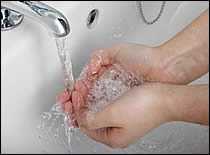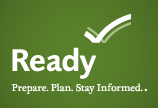Personal Hygiene and Handwashing After a Disaster or Emergency

On This Page
Good basic personal hygiene and handwashing are critical to help prevent the spread of illness and disease. Clean, safe running water is essential for proper hygiene and handwashing.
Hygiene is especially important in an emergency such as a flood, hurricane, or earthquake, but finding clean, safe running water can sometimes be difficult. The following information will help to ensure good hygiene and handwashing in the event of an emergency.
Disaster Supplies Kit (Hygiene Supplies)
- Before an emergency, make sure you have created a Disaster Supplies Kit.
Handwashing
Keeping hands clean during an emergency helps prevent the spread of germs. If your tap water is not safe to use, wash your hands with soap and water that has been boiled or disinfected. Follow these steps to make sure you wash your hands properly:
- Wet your hands with clean, running water (warm or cold) and apply soap.
- Rub your hands together to make a lather and scrub them well; be sure to scrub the backs of your hands, between your fingers, and under your nails.
- Continue rubbing your hands for at least 20 seconds. Need a timer? Hum the “Happy Birthday” song from beginning to end twice.
- Rinse your hands well under running water.
- Dry your hands using a clean towel or air dry them.
A temporary hand washing station can be created by using a large water jug that contains clean water (for example, boiled or disinfected).
Washing hands with soap and water is the best way to reduce the number of germs on them. If soap and water are not available, use an alcohol-based hand sanitizer that contains at least 60% alcohol. Alcohol-based hand sanitizers can quickly reduce the number of germs on hands in some situations, but sanitizers do not eliminate all types of germs.
Hand sanitizers are not effective when hands are visibly dirty.
When to Wash Hands

Wash hands with soap and clean, running water (if available):
- Before, during, and after preparing food
- Before eating food
- After using the toilet
- After changing diapers or cleaning up a child who has used the toilet
- Before and after caring for someone who is sick
- After blowing your nose, coughing, or sneezing
- After touching an animal or animal waste
- After touching garbage
- Before and after treating a cut or wound
Other Hand Hygiene Resources
- Food and Water Safety and Hand Hygiene Resources
- Handwashing: Clean Hands Save Lives
- Safe and Healthy Diapering for Emergency Settings
Do not use contaminated water to wash dishes, brush your teeth, wash and prepare food, or make ice.
Bathing
Bathing or showering after a water-related emergency should only be done with clean, safe water. Sometimes water that is not safe to drink can be used for bathing, but be careful not to swallow any water or get it in your eyes.
If you have a drinking water well, listen to your local health authorities for advice on using your well water for showering and bathing. If extensive flooding has occurred or you suspect that your well may be contaminated, contact your local, state, or tribal health department for specific advice on well testing and disinfection.
Dental Hygiene
- Brushing your teeth after a water-related emergency should only be done with clean, safe water. Listen to local authorities to find out if tap water is safe to use.
- Visit the Safe Drinking Water for Personal Use page for more information about making your water safe for brushing your teeth.
- You may visit CDC’s Oral Health Web site for complete dental hygiene information.
Wound Care
Keeping wounds clean and covered is crucial during an emergency. Open wounds and rashes exposed to flood waters can become infected. To protect yourself and your family:
- Avoid contact with flood waters if you have an open wound.
- Cover clean, open wounds with a waterproof bandage to reduce chance of infection.
- Keep open wounds as clean as possible by washing well with soap and clean water.
- If a wound develops redness, swelling, or oozing, seek immediate medical care.
- Vibrios are naturally occurring bacteria that live in certain coastal waters. They can cause a skin infection when an open wound is exposed to salt water or a mix of salt and fresh water, which can occur during floods.
The risk for injury during and after a hurricane and other natural disasters is high. Prompt first aid can help heal small wounds and prevent infection. Wash your hands with soap and water before and after providing first aid for a wound to help prevent infection. Use an alcohol-based hand sanitizer that contains at least 60% if soap and water are not available. Tetanus, other bacterial infections, and fungal infections are potential health threats for persons who have open wounds.
Seek medical attention as soon as possible if:
- There is a foreign object (soil, wood, metal, or other objects) embedded in the wound;
- The wound is at special risk of infection (such as a dog bite or a puncture by a dirty object);
- An old wound shows signs of becoming infected (increased pain and soreness, swelling, redness, draining, or you develop a fever).
Healthcare professionals should visit Emergency Wound Management for Healthcare Professionals and Guidance for Management of Wound Infections.
Additional Hygiene Information
- Page last reviewed: August 28, 2017
- Page last updated: October 12, 2017
- Content source:


 ShareCompartir
ShareCompartir

